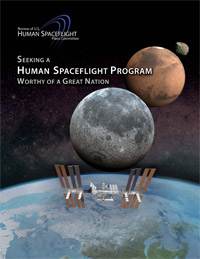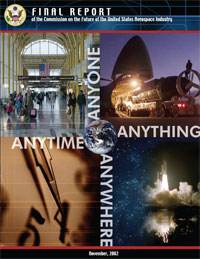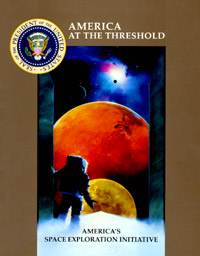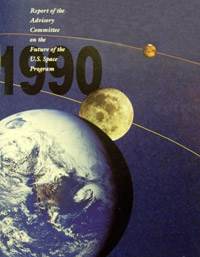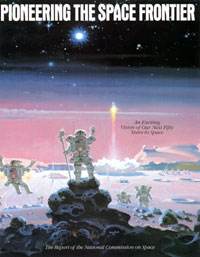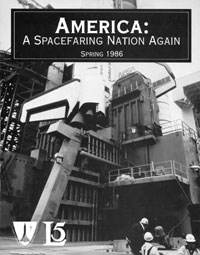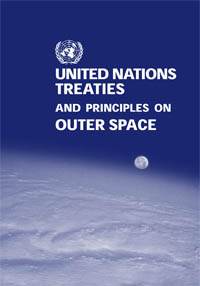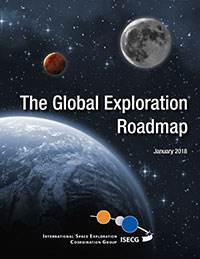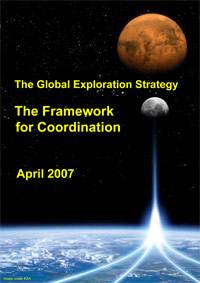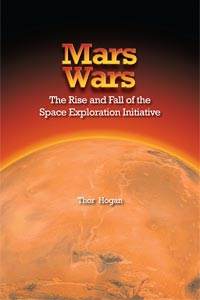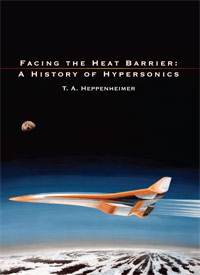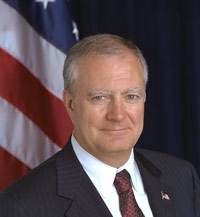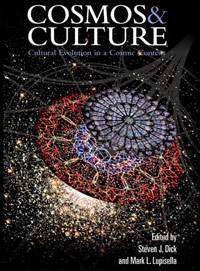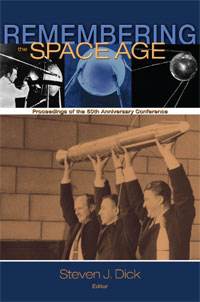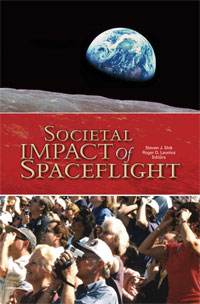Part I: Commission Reports
FINAL REPORT of the Review of U.S. Human Space Flight Plans Committee [PDF 7.8 MB] 157 pages, October 22, 2009. Known as the “Augustine Report” after Chairman Norman Augustine. SUMMARY REPORT of the Review of U.S. Human Space Flight Plans Committee [PDF] September 8, 2009. “The Committee concluded that the ultimate goal of human exploration is to chart a path for human expansion into the solar system.“
Report of the President’s Commission on Implementation of United States Space Exploration Policy, 2004, 64 pages [PDF 1.3 MB]. The Commission (the “Aldridge” Commission chaired by Edward C. “Pete” Aldridge, Jr.), was charged with making recommendations to the President on implementing the Vision for Space Exploration to the Moon, Mars, and beyond. The report called for a transformation of NASA, building a robust international space industry, a discovery-based science agenda, and educational initiatives to support youth and teachers inspired by the vision. See summary article from Ad Astra.
Final Report of the Commission on the Future of the United States Aerospace Industry, 2002. “The ability to access space and travel through the solar system in weeks or months instead of years would help create the imperative to do so. Propulsion and power are the key technologies to enable this capability. Future progress in these areas will result in new opportunities on Earth and open the solar system to robotic and human exploration and eventual colonization. The nation would benefit from a joint effort by NASA and DoD to reduce significantly the cost and time required to access and travel through space.”
America at the Threshold – Report of the Synthesis Group on America’s Space Exploration Initiative, 1991, 191 pages [PDF off site; separate links for Life Sciences and Architecture IV]. Known as the “Stafford” report after Chairman Thomas P. Stafford. The Synthesis Group was charged by Vice-President Quayle and NASA Administrator Richard Truly to seek out the best and most innovative ideas in the country. The report described four alternative architectures: (1) Mars exploration, (2) science emphasis for the Moon and Mars, (3) the Moon to stay and Mars exploration, and (4) space resource utilization.
Report of the Advisory Committee On the Future of the U.S. Space Program, December 1990, 60 pages [PDF 0.6 MB]. Known as the “Augustine Report” after Chairman Norman Augustine. It is recommended that the United States’ future civil space program consist of a balanced set of five principal elements: a science program, which enjoys highest priority within the civil space program, and is maintained at or above the current fraction of the NASA budget; a Mission to Planet Earth (MTPE) focusing on environmental measurements; a Mission from Planet Earth (MFPE), with the long-term goal of human exploration of Mars, preceded by a modified Space Station which emphasizes life sciences, an exploration base on the Moon, and robotic precursors to Mars; a significantly expanded technology development activity, closely coupled to space mission objectives, with particular attention devoted to engines; a robust space transportation system.
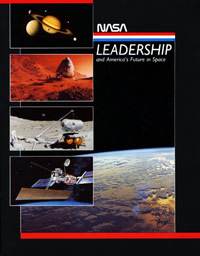
Leadership and America’s Future in Space: A Report to the NASA Administator by Dr. Sally K. Ride (the “Ride Report”), August, 1987. HTML version (no illustrations) – Image PDF version (fully illustrated). By 2010, up to 30 people would be productively living and working on the lunar surface for months at a time. Lunar oxygen will be available for use at the outpost and possibly for propellant for further exploration. Exploring, prospecting, and settling are parts of our heritage and will most assuredly be parts of our future.
Pioneering the Space Frontier – Report of the National Commission on Space, 1986, 214 pages. Appointed by President Reagan and chaired by former NASA Administrator Thomas Paine, the National Commission on Space was charged with recommending a civilian space program that would advance the broader goals of American society over the next century. The Commission recommended a new direction “to lead the exploration and development of the space frontier, advancing science, technology, and enterprise, and building institutions and systems that make accessible vast new resources and support human settlements beyond Earth orbit, from the highlands of the Moon to the plains of Mars.”
America: A Spacefaring Nation Again – Citizens’ Advisory Council on National Space Policy, 1986. Written just after the loss of Challenger, this report proposed a Commercial Space Incentive Act whereby the United States would guarantee every year to pay $500 per pound for the first one million pounds placed into orbit by private US companies (to qualify, an orbital payload must be at least ten thousand pounds).
Space: The Crucial Frontier – Citizens’ Advisory Council on National Space Policy, 1981, 48 pages. The Citizens’ Advisory Council was created in 1981 by joint action of the American Astronautical Society and the L5 Society for the purpose of developing a detailed and technically feasible space policy to further the national interest. The Council wrote: “The statesmen who lead mankind permanently to space will be remembered when Isabella the Great and Columbus are long forgotten.”
Part II: Other Space Policy References
- Treaty on Principles Governing Activities of States in the Exploration and Use of Outer Space, including the Moon and other Celestial Bodies, 1967 (“Outer Space Treaty”)
- Agreement on the Rescue of Astronauts, the Return of Astronauts, and the Return of Objects Launched into Outer Space, 1968 (“Rescue Agreement”)
- Convention on International Liability for Damage Caused by Space Objects, 1973 (“Liability Convention”)
- Convention on Registration of Objects Launched into Outer Space, 1976 (“Registration Convention”)
- Treaty Governing the Activities of States on the Moon and Other Celestial Bodies, 1979 (“Moon Treaty”)
Video: Stephen Hawking speaks on “Why We Should Go Into Space” for NASA’s 50th Anniversary lecture series at George Washington University, April 21, 2008. 25-minute video (with transcript). Hawking advocates the colonization of the Moon and Mars.
The Global Exploration Roadmap, 2018, 36 pages [PDF 9.1 MB]. Agencies participating in the International Space Exploration Coordination Group (ISECG) continue to advance a long-range international exploration strategy to expand human presence into the Solar System, which begins with the International Space Station, proceeds to the Moon, and leads to human missions to explore Mars. This third edition of the Global Exploration Roadmap, first released in September 2011 and updated in August 2013, includes updated agency plans and programmes and aims to facilitate stakeholder engagement within countries and across space agencies to realise human and robotic exploration of destinations where humans may one day live and work.
The Global Exploration Strategy: The Framework for Coordination, 2007, 23 pages [PDF 0.4 MB]. In 2006, 14 national space agencies took the unprecedented step of elaborating a vision for peaceful robotic and human space exploration, focusing on destinations within the solar system where humans may one day live and work, and developed a common set of key space exploration themes. This document is the result of that work. The human migration into space is still in its infancy. For the most part, we have remained just a few kilometres above the Earth’s surface – not much more than camping out in the backyard. It is time to take the next step. The Moon will be the first place where humans learn to live on another celestial body. Exploration of the Moon will reveal whether the resources available in space will allow humans to live off the land.
Mars Wars: The Rise and Fall of the Space Exploration Initiative, by Thor Hogan, NASA-SP4410, 2007, 194 pages [PDF 9.4 MB] [review]. The rise of Space Exploration Initiative (SEI) and its eventual demise represents one of the landmark episodes in the history of the American space program. The story of this failed initiative is one shaped by key protagonists and critical battles. It is a tale of organizational, cultural, and personal confrontation. Skirmishes involved the Space Council versus NASA, the White House versus congressional appropriators, and the Johnson Space Center versus the rest of the space agency, all seeking control of the national space policy process. The demise of SEI was a classic example of a defective decision-making process that lacked adequate high-level policy guidance, failed to address critical fiscal constraints, developed inadequate programmatic alternatives, and garnered no congressional support. Some space policy experts have argued that SEI was doomed to fail, due primarily to the immense budgetary pressures facing the nation during the early 1990’s. This book argues, however, that the failure of the initiative was not predetermined but was instead the result of a deeply flawed policy process that failed to develop (or even consider) policy options that may have been politically acceptable given the existing political environment. The author, Thor Hogan, is Assistant Professor of Political Science at Illinois Institute of Technology.
Facing the Heat Barrier: A History of Hypersonics, by T. A. Heppenheimer, NASA-SP4232, 2007, 336 pages [PDF 1.9 MB]. Although primarily a history of hypersonic technology development rather than space policy per se, of particular interest from a space policy perspective are the discussions of efforts to develop scramjet technology (including the X-33 and X-34) and the section on the failure of the National Aerospace Plane (NASP) project.
- 44th Robert H. Goddard Memorial Symposium Keynote Address, March 15, 2006: “Questions about the vision boil down to whether we want to incorporate the Solar System in our economic sphere, or not.”
- 46th Robert H. Goddard Memorial Symposium Keynote Address, March 6, 2008
Space 2030: Tackling Society’s Challenges, Organisation for Economic Cooperation and Development, 2005, 334 pages [PDF 3.6 MB off site]. This publication is the final report on a two-year OECD Futures Project devoted to the commercialization of space, the development of space infrastructure and the role to be played by public and private actors. The book explores the contribution space systems might make in dealing with looming societal challenges related to threats to the physical environment and the management of natural resources, growing mobility and its consequences, increasing security concerns, and the shift to the information society. In addition, it formulates an overall policy framework that OECD governments might use in drafting policies designed to ensure that the potential that space has to offer is actually realized.
Space 2030: Exploring the Future of Space Applications, Organisation for Economic Cooperation and Development, 2004, 240 pages [PDF 1.4 MB off site]. Where is the space sector heading now? What are the obstacles to its further development? What are its future prospects? What are the applications that are likely to be successful in the future? To answer these questions, this report adopted a scenario-based approach to explore the future evolution of major components of the space sector (military space, civil space, commercial space) over the next thirty years. It covers four major factors of change: geopolitical developments, socio-economic developments, energy and the environment, and technology.
The Space Shuttle Decision: NASA’s Search for a Reusable Space Vehicle by T. A. Heppenheimer. 470 pages, 1999. NASA SP-4221. NASA History Series: Volume 1 of The History of the Space Shuttle. This significant study of the decision to build the Space Shuttle explains the Shuttle’s origins and early development. In addition to internal NASA discussions, this work details the debates in the late 1960s and early 1970s among policymakers in Congress, the Air Force, and the Office of Management and Budget over the roles and technical designs of the Shuttle. Examining the interplay of these organizations with sometimes conflicting goals, the author not only explains how the world’s first reusable space launch vehicle came into being, but also how politics can interact with science, technology, national security, and economics in national government.
Reaching for the High Frontier: The American Pro-Space Movement, 1972-84, by Michael A. G. Michaud. 436 pages, 1986. This book provides an informal, capsule history of the pro-space movement in the United States from 1972 through 1984 and presents a simple analysis of American pro-space groups as an interest group phenomenon. A new generation of space advocates emerged, convinced that space holds answers to such real-world problems as economic growth, environmental degradation, international tension and the threat of nuclear war, and the need for a hopeful future. By the early 1980s, the groups formed were showing increasing political sophistication and entrepreneurship as they pursued both direct and indirect approaches to expanding human activity in space.
Part III: NASA Compendiums on Space and Culture
NASA’s First 50 Years: Historical Perspectives, edited by Steven J. Dick. NASA-SP4704, 2010, 765 pages [PDF 9.2 MB]. In this volume, a wide array of scholars attending NASA’s 50th Anniversary Conference examines NASA’s first 50 years, probing an institution widely seen as the premier agency for exploration in the world, carrying on a long tradition of exploration by the United States and the human species in general. Fifty years after its founding, NASA finds itself at a crossroads that historical perspectives can only help to illuminate.
Cosmos & Culture: Cultural Evolution in a Cosmic Context, edited by Steven J. Dick and Mark L. Lupisella. NASA-SP4802, 2009, 612 pages [PDF 4.0 MB]. Integrating concepts from philosophical, anthropological, and astrobiological disciplines, Cosmos and Culture begins to explore the interdisciplinary questions of cosmic evolution. From Chapter 11: While the exact time scale of these projects is subject to the vagaries of political will, one can conservatively foresee that within two centuries, at most, enough of us will be off the planet – in O’Neill colonies, on the Moon and Mars, and burrowed into the asteroids – that total annihilation of human society will be as impossible as the total annihilation of Earth’s ants. We will be dispersed, and dispersal is the ultimate insurance policy for survival.
Remembering the Space Age, edited by Steven J. Dick. NASA-SP4703, 2008, 480 pages [PDF 8.9 MB]. This book is an edited collection of 21 essays stemming from an October 2007 conference sponsored by the NASA History Division and the National Air and Space Museum to commemorate the 50th anniversary of the dawn of the Space Age. This book is not “just another space history” but instead examines the meaning of the Space Age in the broadest possible sense. It is an examination of the place of space exploration in human history and how the record of the Space Age has been preserved and represented in the wider culture. The essays cover a diverse range of topics from “Robert A. Heinlein’s Influence on Spaceflight” to “Cosmonaut Nostalgia in Soviet and Post-Soviet Film” to “China’s Human Spaceflight Program and Chinese National Identity” to “Cultural Functions of Space Exploration,” and much more.
Societal Impact of Spaceflight, edited by Steven J. Dick and Roger D. Launius. NASA-SP4801, 2007, 695 pages [PDF 9.7 MB]. Fifty years after the Space age began, this conference proceedings examines the effects of spaceflight on society in a historically rigorous way. Has the Space age indeed had a significant effect on society? If so what are those influences? What do we mean by an “impact” on society? And what parts of society? Conversely, has society had any effect on spaceflight? What would be different had there been no Space Age? The purpose of this volume is to examine these and related questions through scholarly research, making use especially of the tools of the historian and the broader social sciences and humanities. Herein a stellar array of scholars does just that and arrives at sometimes surprising conclusions. Spaceflight has commercial and economic dimensions as well as social, cultural and ideological ramifications. It touches on enduring American values of pioneering, progress, enterprise and rugged individualism. Worldwide it encompasses international cooperation and competition, and affects foreign policies, national security, and questions of global environment. Viewing Earth from space, and space from the vicinity of Earth, alters world views, conceptions of self and others, and our understanding of our place and purpose in the universe.

